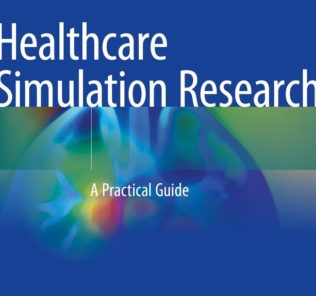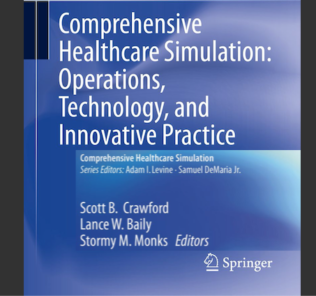New Comprehensive List of Must-Read Healthcare Simulation Books!
Healthcare Simulation books are a must for professionals looking to develop or expand a medical simulation program. As conferences are few and far between and educational simulation degrees extremely limited, reading healthcare simulation books can really help provide your program with the advice gained from years of trial and error from leading experts! Our new Healthcare Simulation Books page provides a comprehensive list of all the major reading for our specialized field. From Building a New Simulation Program to Medical Moulage, and from Scenario Libraries to Lessons on Patient Safety from Aviation — the new Medical Simulation Books page has it all! Check out just a handful of the comprehensive recommendations, usually under $100 from Amazon, highlighted on our new Healthcare Simulation Books Page:
The Comprehensive Textbook of Healthcare Simulation is a cohesive, single-source reference on all aspects of simulation in medical education and evaluation. It covers the use of simulation in training in each specialty and is aimed at healthcare educators and administrators who are developing their own simulation centers or programs and professional organizations looking to incorporate the technology into their credentialing process. For those already involved in simulation, the book will serve as a state-of-the-art reference that helps them increase their knowledge base, expand their simulation program’s capabilities, and attract new, additional target learners.
Healthcare Simulation Education: Evidence, Theory and Practice is written by a leading team from the Australian Society for Simulation in Healthcare (ASSH) and Simulation Australasia, and is a new resource for a rapidly expanding professional healthcare simulation community. Designed as a core reference for educators who use simulation as an educational method, it outlines theory, evidence and research relevant to healthcare simulation. Containing examples of innovations from around the world, the book offers opportunities to make clear connections between the underlying rationale for the use of simulation, and what this looks like in practice.
Sponsored Content:
Simulation Champions: Fostering Courage, Caring, and Connection
draws on the personal experiences of experts and pioneers in the field, and offers the practical information needed to deal with the real challenges of creating or improving a simulation program, along with detailed information on the change management and leadership skills needed for success. Whether you are building a nursing simulation program from the ground up or are seeking to improve an existing program, you will find the information and tools you need to develop strategies for adoption, maintenance, and evaluation, including coverage of important considerations, such as physical space, budget, curriculum and human resources. The book features extensive coverage of leadership and management concepts critical to implementing a simulation program prepares you for potential challenges and pitfalls, including change management strategies and ready-to-use online templates to help you implement key concepts and skills.
Clinical Simulations for Nursing Education: Instructor Volume helps your students develop and practice the critical assessment, clinical reasoning, and nursing care skills they need to deliver safe and effective patient care in a controlled, risk-free environment. 51 structured simulation scenarios—34 in print and 17 on DavisPlus, the F.A. Davis password-protected site—cover the entire nursing curriculum. Each simulation scenario focuses on a defined clinical domain, critical knowledge and skills, levels of competency, evidenced-based practice guidelines, National Patient Safety Goals, and research-based design characteristics.
Pocket Book for Simulation Debriefing in Healthcare is a concise manual on debriefing techniques in a clinical educational context. It presents the most popular debriefing techniques and, hence, can be used as a reference manual by educators to help them achieve their intended debriefing objectives. The overarching objective of debriefing is to promote reflection and improve patient safety awareness at an individual and a team level. This book provides clear explanations of what constitutes a valuable and effective debriefing, and presents the various approaches that can be used and how debriefing differs from feedback. It includes key recommendations on aspects that directly or indirectly impact debriefing with different populations of learners such as students or qualified healthcare professionals of various levels of seniority. This book can also be used as a survival guide for both simulation educators and clinicians during debriefings.
Comprehensive Healthcare Simulation: Pediatricsis a practical guide to the use of simulation in pediatric training and evaluation, including all subspecialty areas. It covers scenario building, debriefing and feedback, and it discusses the use of simulation for different purposes: education, crisis resource management and interdisciplinary team training, competency assessment, patient safety and systems integration. Readers are introduced to the different simulation modalities and technologies and guided on the use of simulation with a variety of learners, including medical students, residents, practicing pediatricians, and health-related professionals. Separate chapters on each pediatric subspecialty provide practical advice and strategies to allow readers to integrate simulation into existing curriculum.
Sponsored Content:
Medical Moulage: How to Make Your Simulations Come Aliveis a large, beautiful, hardbound book with over 300 special effects recipes and scenarios for field and clinical simulations. Simple recipes designed for the beginner through advanced user including 1,200 vibrant, full-color illustrations, step-by-step directions, ingredient customization, pre-make, storage and “Set the Stage,” a quick guide to staging realistic training in both field and clinical environments. This comprehensive moulage manual includes staged wounds, cyanosis, mottling, blisters that rupture, sutured wounds, odors and just about everything in-between. Heighten the realism in your training simulations with this easy to use moulage training manual.
Teaching Health Care in Virtual Space: Best Practices for Educators in Multi-User Virtual Environmentsis the first “how-to” manual for health educators on the instructional use of three-dimensional, computer-generated virtual environments that can be inhabited simultaneously by many participants; commonly called “multi-user virtual learning environments” or MUVE. Based on her experience supervising more than 400 learning activities in Second Life, Dr. Estelle Codier has written a step-by-step handbook for novice and experienced MUVE teachers alike. The book provides those new to virtual teaching with specific steps to assess their own instructional readiness, guidance for assessing student and class readiness, as well as detailed descriptions of problem prevention and solutions. The text is accompanied by lively case studies of both success and failure in virtual learning environments. Inspiring stories of student learning illustrate the power of MUVE to transform health care education.
Black Box Thinking: Why Most People Never Learn from Their Mistakes–But Some Do shows in this eye-opening book, the answer to Medical Error is rooted in human psychology and organizational culture. Syed argues that the most important determinant of success in any field is an acknowledgment of failure and a willingness to engage with it. Yet most of us are stuck in a relationship with failure that impedes progress, halts innovation, and damages our careers and personal lives. We rarely acknowledge or learn from failure—even though we often claim the opposite. We think we have 20/20 hindsight, but our vision is usually fuzzy. Syed draws on a wide range of sources—from anthropology and psychology to history and complexity theory—to explore the subtle but predictable patterns of human error and our defensive responses to error. He also shares fascinating stories of individuals and organizations that have successfully embraced a black box approach to improvement, such as David Beckham, the Mercedes F1 team, and Dropbox.
Simulation in Healthcare Education: An Extensive History gives a narrative history of the development of simulators from the early 1700s to the middle of the 20th century when simulation in healthcare appeared to all but die out. It is organized around the development of simulation in different countries and includes at the end a guide to simulators in museums and private collections throughout the world. The aim is to increase understanding of simulation in the professional education of healthcare providers by exploring the historical context of simulators that were developed in the past, what they looked like, how they were used, and examples of simulator use that led to significant harm and an erosion of standards. The book is addressed to the healthcare simulation community and historians of medicine. The latter in particular will appreciate the identification and use of historic sources written in Latin, German, Italian, French, Polish and Spanish as well as English.
See all the Latest & Healthcare Great Healthcare Simulation Books Here!
Lance Baily, BA, EMT-B, is the Founder & CEO of HealthySimulation.com, which he started while serving as the Director of the Nevada System of Higher Education’s Clinical Simulation Center of Las Vegas back in 2010. Lance is also the Founder and acting Advisor to the Board of SimGHOSTS.org, the world’s only non-profit organization dedicated to supporting professionals operating healthcare simulation technologies. His co-edited Book: “Comprehensive Healthcare Simulation: Operations, Technology, and Innovative Practice” is cited as a key source for professional certification in the industry. Lance’s background also includes serving as a Simulation Technology Specialist for the LA Community College District, EMS fire fighting, Hollywood movie production, rescue diving, and global travel. He and his wife Abigail Baily, PhD live in Las Vegas, Nevada with their two amazing daughters.
Sponsored Content:




















